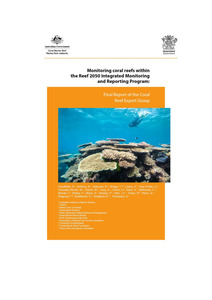Please use this identifier to cite or link to this item:
https://hdl.handle.net/11017/3562

Full metadata record
| DC Field | Value | Language |
|---|---|---|
| dc.contributor.author | Schaffelke, B. | - |
| dc.contributor.author | Anthony, K. | - |
| dc.contributor.author | Babcock, R. | - |
| dc.contributor.author | Bridge, T. | - |
| dc.contributor.author | Carlos, E. | - |
| dc.contributor.author | Diaz-Pulido, G. | - |
| dc.contributor.author | Gonzalez-Rivero, M. | - |
| dc.contributor.author | Gooch, M. | - |
| dc.contributor.author | Hoey, A. | - |
| dc.contributor.author | Horne, D. | - |
| dc.contributor.author | Kane, K. | - |
| dc.contributor.author | McKenzie, C. | - |
| dc.contributor.author | Merida, F. | - |
| dc.contributor.author | Molloy, F. | - |
| dc.contributor.author | Moon, S. | - |
| dc.contributor.author | Mumby, P. | - |
| dc.contributor.author | Ortiz, J.C. | - |
| dc.contributor.author | Pears, R. | - |
| dc.contributor.author | Phinn, S. | - |
| dc.contributor.author | Ridgway, T. | - |
| dc.contributor.author | Roelfsema, C. | - |
| dc.contributor.author | Singleton, G. | - |
| dc.contributor.author | Thompson, A. | - |
| dc.date.accessioned | 2020-02-27T04:19:46Z | - |
| dc.date.available | 2020-02-27T04:19:46Z | - |
| dc.date.copyright | 2020 | en |
| dc.date.issued | 2020 | en |
| dc.identifier.isbn | 9780648589211 | en |
| dc.identifier.uri | https://hdl.handle.net/11017/3562 | - |
| dc.description.abstract | [Extract] The Coral Reef Expert Group (CREG) was one of eight expert groups, which all followed a prescribed process to recommend a design for their thematic component. The tasks of the expert groups included: • Synopsis of the theme, to include discussion on current state, primary drivers, pressures and responses using DPSIR framework. • Review of all current monitoring and modelling activities relevant to the expert group theme. • Identify candidate indicators that can be monitored and would provide information about trend, status or forecasting of value or the system. • Evaluation of the adequacy and confidence of current monitoring and modelling of candidate indicators, determined by their ability to meet the objectives of the RIMReP and management needs provided by the Authority. • Identification and discussion of gaps and opportunities in current monitoring and modelling of such indicators. • Evaluation of new monitoring technologies for their potential to increase efficiency or statistical power and their compatibility with long-term datasets. • Recommendations for monitoring design including consideration of primary indicators, continuity of data sets, how the design addresses management needs, modification to existing programs, costing and transition strategies. | en |
| dc.description.abstract | An accessible copy of this report is not yet available from this repository, please contact elibrary@gbrmpa.gov.au for more information. | en |
| dc.publisher | Great Barrier Reef Marine Park Authority | en |
| dc.relation.ispartofseries | Reef 2050 | en |
| dc.relation.ispartofseries | Coral Reef Expert Group (RIMRep) | en |
| dc.rights | This document is licensed for use under a Creative Commons Attribution-NonCommercial 4.0 International licence with the exception of the Coat of Arms of the Commonwealth of Australia, the logos of the Great Barrier Reef Marine Park Authority and the Queensland Government, any other material protected by a trademark, content supplied by third parties and any photographs. For licence conditions see: https://creativecommons.org/licenses/by-nc/4.0/ | en |
| dc.subject.other | Reef Ecosystems & Marine Species | en |
| dc.title | Monitoring coral reefs within the Reef 2050 Integrated Monitoring and Reporting Program: final report of the coral reef expert group | en |
| dc.type | Report | en |
| dc.format.pages | 73 | en |
| dc.contributor.corpauthor | Australian Institute of Marine Science | en |
| dc.contributor.corpauthor | Great Barrier Reef Marine Park Authority | en |
| dc.publisher.place | Townsville | en |
| dc.relation.connectiontogbrmpa | GBRMPA published this item | en |
| dc.subject.category | Ecosystems | en |
| dc.subject.location | Reef-wide | en |
| dc.keywords | Reef 2050 | en |
| Appears in Collections: | Ecosystems | |
Files in This Item:
| File | Description | Size | Format | |
|---|---|---|---|---|
| Final Report for the Coral Reef Expert Group.pdf | Main report (PDF) | 3.41 MB | Adobe PDF |  View/Open |
This item is licensed under a Creative Commons License

